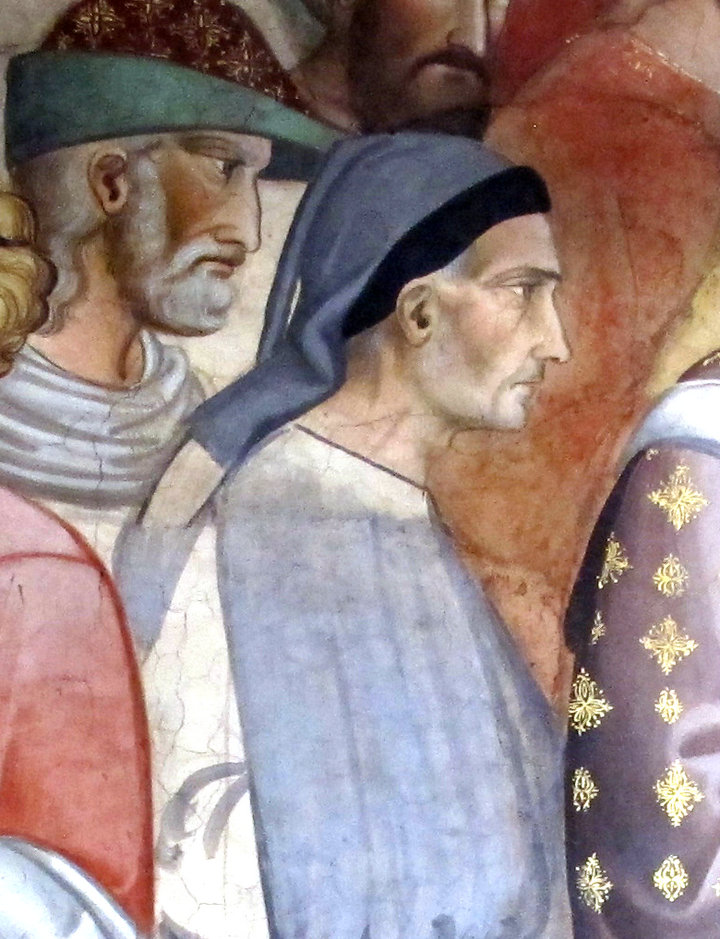Taddeo Gaddi (1300 – 1366) was an Italian painter from the 14th century, belonging to the Gaddi family
Father of Painters John, Agnolo and Niccolò Gaddi He also had a fourth son, Zanobi, who seems to have not taken the career of an artist
It was probably, as Vasari argued, Giotto’s disciple with greater talent or whatever he was able to carry on with the style of the great master. In 1347 he is remembered at the top of a list of the best painters in Florence
Among his works the most important is the cycle of frescoes with Stories of the Virgin in the Baroncelli Chapel of the Basilica of Santa Croce in Florence (1328-1338). Shortly thereafter he had to wait for the painting of the Formulas of the closet of the Sacrament of Holy Cross, today At the Galleria dell’Accademia in Florence, in Munich and in Berlin. In this prestigious work, he demonstrated that he had succeeded in the teachings of Giotto, possessing a considerable narrative freedom with figures in the scenes, which are more crowded than his master He also resumes the experimentation of perspective in architectural backgrounds and reaches bold results as in the oblique and broken staircase in the Virgin Presentation at the Temple
He was a collaborator, according to some, at Polittico Stefaneschi (Rome) I still remember Madonna (Bern), Adoration of the Magi (Dijon), Stories of Job (Pisa, Camposanto), Our Lady on the throne with the Child, angels and (Florence, Uffizi), Madonna del Parto (Florence), Polittico (Florence, Santa Felicita) From Vasari is also credited with the design of the Ponte Vecchio reconstruction, today questioned by scholars who point to Blacks Fioravante
Thaddeo Gaddi, in the “giottesco” field, has a unmistakable style with sometimes sought-after effects of night light, almost an unicum in the 14th century painting of central Italy. The space works sought in some of his works are often majestic and Solemn, approaching this in Maso di Banco The delicate and soft faces of the faces are indicative of the late development of Taddeo’s art
Among the ancient sources dealing with Taddeo Gaddi there are Franco Sacchetti (Trecentonovelle, CXXXVI), Cennino Cennini (Book of Art), Lorenzo Ghiberti (Commentari) and Giorgio Vasari, including a biography in Life Cennini himself Opening of his work, immediately clarifies his direct artistic descent by Giotto specifying that “Agnolo di Taddeo from Florence my master, who learned the said art from his father Taddeo; Whose father was baptized by Giotto and was his XXII-year-old disciple. “What for Cennini is a claim of his own” artistic license “(in controversy perhaps with the Orcagna brothers who went to the greatest but could not boast such genealogy) , In the first place was transformed, for the sake of Taddeo, as a heavy artistic legacy of his master, to be handed down and handed over to his child as less corrupt as possible. It was also the novel 136 of the Sacchetti, A group of Florentine painters and sculptors around 1360 find themselves dined together on the hill of San Miniato al Monte, after having provided artistic advice to estimate the work of some of their fellow Andrea Orcagna, the parvenu, you can ask who was the greatest Painter “by Giotto out” (maybe hoping it was his name to go out), and his colleagues walk in a series of names, from Cimabue to Bernardo Dad From Stefano to Buonamico Buffalmacco, as long as he decides to give the word to the eldest, Taddeo, the best known to Giotto, the artist’s answer is lucid and lapidary: “this art has come and goes missing every day” , That is, no one
Filippo Villani likened Taddeo to Dinocrate and Vitruvio, believing Vasari that he was also an architect. The historic arena assigned him the bridge of the Frescobaldi, the Ponte Vecchio (today given to Neri di Fioravante), the upper part of Orsanmichele and the Completion of the bell tower of Giotto: the infallibility of such attributions was then demonstrated by Gaetano Milanesi in his commentary on the Vines Probably the statement of the Villani (“Taddeus insuper aedificii so much art depinxit, ut de dynocrates vel Victruvius here architecturae artem scripserit, videretur” ) Is to be understood as a praise of his ability to draw architecture in his works
The first modern contributions to critics on Taddeo Gaddi date back to Cavalcaselle, to Adolfo Venturi (1907), to Van Marle, who basically followed the traditional position of praising him as Giotto’s principal pupil but without considering him as an independent teacher. Pietro Toesca in the 14th century work
For a more in-depth and objective understanding of Gaddi’s art we have to wait for two articles by Roberto Longhi on Comparison of 1959 (nn 109 and 111, Quality and Industry in Taddeo Gaddi). This was followed by a series of contributions to the reconstruction of the catalog and a More objective criticism of the artist by Klara Steinweg (1964, Mitteilungen des Kunsthistorischen Institutes in Florenz), Ilaria Toesca (1950, Comparison 3), Boskovits (1964, Catalog of the Museum of Esztergom), Luciano Bellosi (Comparison 187) A complete list of the painter’s bibliography is found in Gandolfo’s article on New Art Criticism
